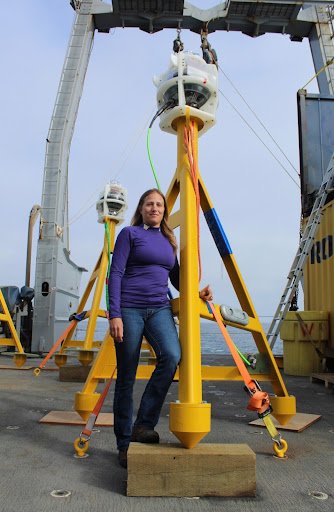That’s So Fetch!
By Leilani Combs
Four hundred and eighty kilometers from the Oregon Coast lies an active submarine volcano known as Axial Seamount, which erupted in 1998, 2011, and again in 2015. It is the most studied underwater volcano in the world, in part, thanks to the Regional Cabled Array (RCA), funded by the National Science Foundation as part of the Ocean Observatories Initiative. The RCA includes fiber optic cables running the length of the ocean floor from Pacific City, Oregon, across the Juan de Fuca Plate to Axial, a first-of-its-kind program championed by UW’s Dr. John Delaney. The RCA became operational in 2014. The high power and bandwidth cables power an intricate arrangement of 150 scientific instruments that allow scientists, educators, and the public on shore to access real-time data streaming to shore at the speed of light. This year, the RCA became home to yet another first.
During the third leg of the VISIONS ’22 expedition, which provides annual maintenance to the RCA and offers marine science/engineering field experience to undergraduates, the Axial Acoustic Array was deployed from the UW research vessel the Thomas G. Thompson with the help of the Canadian Remotely Operated Vehicle (ROV) ROPOS. This project, proposed by UW marine geophysicist Dr. William Wilcock and Applied Physics Lab (APL) Engineer Dana Manalang, and funded by the National Science Foundation (NSF), consists of a network of Sonardyne Fetch sensors mounted on tripods built by the APL. The platforms are located on the eastern and western walls of the Axial Caldera, and in the caldera itself ~ 1500 m beneath the ocean’s surface. The Fetch instruments include a pressure gauge, temperature sensor, and velocimeter.
Fetch tripods aboard the R/V Thomas G Thompson awaiting deployment on Leg 3 of the VISIONS ’22 research cruise. (Photo credit: Leilani Combs/ University of Washington)
The Sonardyne Fetch tripods can communicate acoustically by sending sound waves between transponder pairs, but only one of the four is attached to the RCA cable to relay information back to researchers in real-time. Using sound waves sent between the towers to measure distance and height differences, scientists will be able to track inflation and deflation of the volcano and horizontal spreading of the ocean floor around the caldera.
While there is already an extensive record of vertical movement of Axial Seamount starting in 1987, there are limitations to the initial system’s ability to differentiate between magma chamber inflation and faulting activity. It is the hope that using the Sonardyne Fetch array, in conjunction with the data already being collected by the RCA, can help to more clearly identify the role of magma chamber inflation and deflation in identifying the volcano’s eruption patterns.
Applied Physics Lab Engineer Dana Manalang and Fetch Tripod 1. (Photo credit: Leilani Combs/ University of Washington)
In addition to monitoring vertical movement, the tracking of horizontal movement of the caldera may offer new insights into the behavior of the caldera. The horizontal component of the Axial Acoustic Array will help paint a more complete picture of Axial movements around inflation, deflation, and uplift related to faults on the east and west sides of the caldera.
One of the most exciting aspects of the array is the role that it can play in communicating with and directing Underwater Autonomous Vehicles (AUVs). This capability may allow a resident AUV within Axial Caldera to closely monitor the volcano’s behavior and overlying ocean waters before, during, and after an underwater eruption: this would be the first experiment of its kind along a mid-ocean ridge spreading center where 70% of the volcanism on Earth occurs. In addition, AUVs play an essential role in collecting high-quality bathymetric imagery and have even been used to identify previously unknown hydrothermal vent sites.
This is just the start for this freshly placed 10-year installment, which promises to offer exciting research opportunities for UW postgraduates and undergraduates alike.
Learn more about the Ocean Observatories Initiative, the RCA and VISIONS at the links below:
https://oceanobservatories.org


